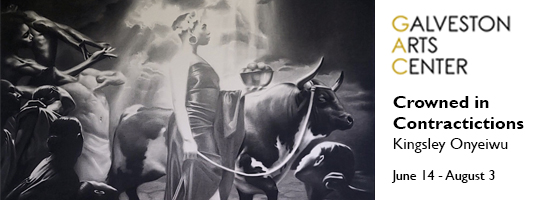Think of the image that comes to your mind when “Buddha” is mentioned. Perhaps he’s a full-faced man sitting cross-legged with a serene smile on his face, or maybe a monk draped in robes with a topknot on his head. These may not be inaccurate depictions, but they’re far from being the only ones. That quickly becomes obvious upon stepping into the Kimbell Art Museum’s new exhibition, Buddha, Shiva, Lotus, Dragon, a collection of nearly 70 items on loan from the Mr. and Mrs. John D. Rockefeller III Collection at Asia Society.
Divided into three principal themes in the history of Asian art—Buddhist sculpture, Hindu sculpture, and East Asian ceramics—something about the geographical arrangement also gives the sense of a backpacking tour through the continent. Starting in India, it leads you through the Himalayas, then China and Southeast Asia, Korea, and over the sea to Japan.
“We can’t all necessarily go and travel; we can’t necessarily go and live in another country or learn a foreign language,” Price explains. “That’s why the Rockefellers wanted to bring this art to America and share it with a wider public audience and use this as a teaching of it.”
Among those was a sculpture of Buddha’s head carved from metamorphic rock, created sometime between the late 2nd and early 3rd centuries and representing the first time the Buddha was shown in human form. Until approximately the 1st century A.D. the “enlightened one” had only been portrayed by symbols – more like the idea of Buddha, less like an actual man. But along the way, followers wanted an image in human form to which they could pray.
Through the centuries and across the regions, the Buddha’s appearance adapted to its respective population. One sculpture in the collection offers more Nepalese traits: A face that’s more square, smaller lips and a sharper nose. A separate 6th century Buddha from Southeast Asia exhibits features of people from Thailand. The styles transition, too. The unadorned, ascetic portrayals in the early centuries give way for a more princely crowned Buddha, bedazzled in lavish jewelry.
As the exhibition’s focus turns to Hindu sculpture, we see the introduction of the Devarāja, or the “God King,” and the incarnation of Shiva, the Hindu deity. One bronze sculpture from the Chola era of India (approximately 9th – 13th centuries) depicts Ganesha, a favorite deity within the Hindu pantheon. With the body of a child and head of an elephant, he’s regarded as the remover of obstacles. Price notes that the hallmark of each of the collection’s Hindu bronzes is the reference to movement in some form, whether through music, dance, literature or poetry. The pièce de resistance, as Price calls it, is a 9th century image of Shiva as Lord of the Dance. Posing with his leg lifted, arms in different gestures and his locks of hair flying out from his head, he holds a drum while trampling a dwarf representing ignorance and illusion. “He does his cosmic dance, he brings the universe back to life,” Price says. “Basically, every now and then, he has to do some cosmic housecleaning.”

1 ⁄7
Head of Buddha Pakistan, Gandhara area Kushan period, late 2nd–early 3rd century Schistose phyllite Asia Society, New York: Mr. and Mrs. John D. Rockefeller 3rd Collection, 1979.2 Photography by Synthescape, courtesy of Asia Society and American Federation of Arts.

2 ⁄7
Crowned Buddha Shakyamuni Kashmir or northern Pakistan 8th century. Brass with inlays of copper, silver and zinc Asia Society, New York: Mr. and Mrs. John D. Rockefeller 3rd Collection, 1979.44 Photography by Synthescape, courtesy of Asia Society and American Federation of Arts.

3 ⁄7
Bodhisattva Avalokiteshvara in the Form of Khasarpana Lokeshvara India, Bihar or Bengal Pala period, late 11th–early 12th century Schist Asia Society, New York: Mr. and Mrs. John D. Rockefeller 3rd Collection, 1979.40 Photography by Synthescape, courtesy of Asia Society and American Federation of Arts.

4 ⁄7
Ganesha India, Tamil Nadu Chola period, 11th century Copper alloy Asia Society, New York: Mr. and Mrs. John D. Rockefeller 3rd Collection, 1979.26 Photography by Synthescape, courtesy of Asia Society and American Federation of Arts.

5 ⁄7
Court Lady North China Tang period, 8th century Earthenware with multicolored lead glazes and traces of pigment (sancai ware) Asia Society, New York: Mr. and Mrs. John D. Rockefeller 3rd Collection, 1979.113 Photography by Synthescape, courtesy of Asia Society and American Federation of Arts.

6 ⁄7
Dish Japan, Saga Prefecture Edo period, 17th century Porcelain painted with underglaze cobalt blue with iron-brown and green glazes (Arita ware, Nabeshima type) Asia Society, New York: Mr. and Mrs. John D. Rockefeller 3rd Collection, 1979.248 Photography by Synthescape, courtesy of Asia Society and American Federation of Arts.

7 ⁄7
Buddha India (probably Bihar) Gupta period, late 6th century Copper alloy 27 × 10 ³/4 × 7 in. (68.6 × 27.3 × 17.8 cm) Asia Society, New York: Mr. and Mrs. John D. Rockefeller 3rd Collection, 1979.8 Photography by Synthescape, courtesy of Asia Society and American Federation of Arts.
This portion of the gallery is a crash course in the complicated practice of ceramics and porcelain making and the evolution of the glazing technique. Adornments take the form of dragons, lotus flowers, tigers and other mythical imagery, with each illustration carrying its own specific meaning. “But as we get into the Yuan Dynasty in the mid-14th century, we have the most important thing that ever happens in the history of Chinese porcelain,” Price says, with a slight dramatic pause, “with this dish right here.” It’s a stunning serving platter made from fine white porcelain clay with intricately painted flowers and a mythical unicorn-like creature in rich cobalt. The dish was created through a complex technique of firing, vitrifying, and glazing. “And voila,” adds Price,” you have the beginning of blue and white porcelain in China, which continues up until today.”
It’s impossible to pick only one centerpiece of the 67 items within Buddha, Shiva, Lotus, Dragon. Each carries its own cultural and historical significance, while also providing a glimpse of the Rockefellers’ refined artistic tastes. “The Rockefellers assembled a collection of Asian art that in many ways echoes the collecting philosophy of the Kimbell,” says the Kimbell’s Director Eric M. Lee. “They aimed to build a collection of masterpieces, with quality valued over quantity.”
Price recounts a statement from John D. Rockefeller III in 1974 to announce his bequest to Asia Society: “My own experience tells me that anyone who becomes acquainted with the arts and cultures of Asia acquires a greatly augmented sense of appreciation and respect for its peoples,” Rockefeller wrote. “We hope that the collection can help instill in Asian-American relations an added sense of importance and opportunity.” To that, Price adds: “Being a scholar of Asian art, and having lived and traveled in Asia myself, I agree with this sentiment 100% and feel it is just as valid today as it was nearly fifty years ago.”
—AMY BISHOP




